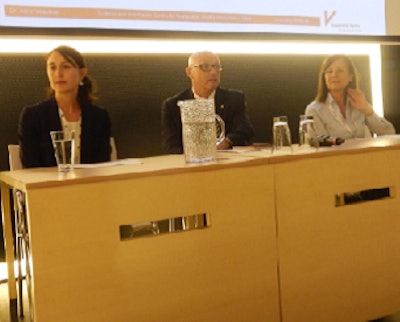
A conference on animal welfare, conducted by WATT Global Media at VIV Europe 2014 on May 21, drew a diverse crowd and numerous questions from the audience. It focused on the poultry industry's role in the implementation of World Organisation for Animal Health (OIE) animal welfare standards, how genetics companies breed for animal welfare, and how a group in Germany is raising consumer awareness of the poultry industry's commitment to animal welfare.
Aline Veauthier, from the Science and Information Centre for Sustainable Poultry Production, Vechta University, Germany, described the organization's program that opens poultry growing houses to the public in northern Germany.
A video of Veauthier detailing the program can be seen online.
She explained that animal welfare groups and the media were presenting a negative view of the poultry industry in Germany. To combat that, the group developed this program to give full transparency to the public. "We want the public informed on modern systems of meat production," she said.
Still in its beginning stages, the program has hosted more than 4,000 visitors on 24 farms, with more than 80 farmers participating.
She explained how the program works. "In general, farm openings take place one Sunday per month, April to October." She explained they are careful to choose farms that are adequate distances apart to keep people from visiting multiple farms in one day, and they choose farms with animals of proper age. "Last weekend, we had 300 visitors on two new farms. We feel the project is an overwhelming success."
When arriving at the farm, visitors enter a tent erected next to a facility. They get general information on poultry farms and are surveyed on their expectations and attitudes prior to the tour. Visitors wear protective clothing and footwear, and biosecurity measures are followed.
After the tour, the visitors take a second survey and the changes of their attitude are tracked. She presented results taken from 3,000 visitors on 15 farms.
Over 40 percent of people taking survey had no previous knowledge of the industry, and 74 percent had not seen a poultry house before. The survey showed their impressions of the industry had improved, especially on air quality and dust in the facilities. She said 81 percent report positive impressions, and 77 percent now disagree with the non-governmental organization (NGO) and media representations of the industry.
Vincent Guyonnet, scientific advisor for the International Egg Commission, gave an outline of the role of the poultry sector in the implementation of the OIE animal welfare standards. The OIE was formed in 1924 to combat disease risks from trans-border transportation of poultry. Since 2001, the group has been leading the development of recommendations on animal welfare practices, and in May 2013 approved recommendations for standards with broiler production systems. Regional or national poultry organizations can then base their regulations or recommendations on these standards.
"These standards are valuable, but must be applied and monitored for compliance locally," said Guyonnet. "There are different methods of this in difference countries." He used the National Chicken Council's animal welfare guidelines and audit checklist as an example of how this is being done in the United States.
He said industry participation is the key. "Studying animal welfare under commercial conditions is critical," said Guyonnet. "The poultry sector is cooperating and helping in developing OIE standards. The challenge now is to get training materials and OIE standards in all countries."
See a video, featuring Guyonnet explaining how should animal welfare be measured.
The third speaker, Anne-Marie Neetson-Van Nieuwenhoven, vice president of Welfare and Compliance for the Aviagen Group, explained how animal welfare is one of the major factors that genetics companies take into account when developing strains of birds.
"We have a balanced breeding program for welfare and sustainability," she said. She added that a very high percentage of the traits they select can be traced back to improved animal welfare and sustainability. She pointed out that those factors are going to be crucial if the industry is going to increase production at the levels needed to support the increased demand for protein in the coming decades.
See her address the role of epigenetics on this video.

















